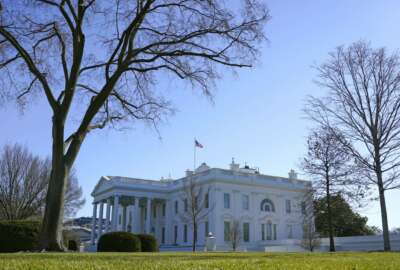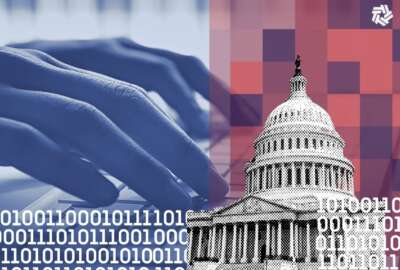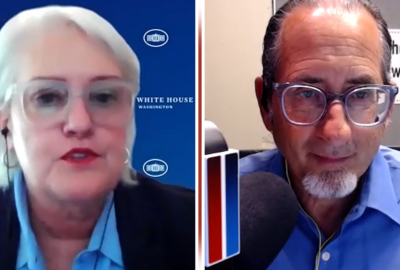
Federal CIO Martorana on her plans for 2023
Federal Chief Information Officer Clare Martorana says among her top priorities for 2023 is break down silos, share lessons learned and scale best practices acr...
As she comes up on her two year anniversary as federal chief information officer in March, Clare Martorana may not be the flashiest person to hold that position.
She hasn’t come up with 24 Quicksilver projects or at 25-point plan to reform federal IT.
Martorana also hasn’t faced a mega-cyber incident — Solarwinds and Log4j had limited overall impact on agencies unlike, say, the Office of Personnel Management hack.
What she has done over the last nearly two years, however, is steadily evolve how agencies and the administration envision what the impact of federal technology is and will be in the coming decade.
Martorana may be the first federal CIO to view technology not as a standalone sector in the federal government, but as one marbled through customer experience, through the workforce and through making the government more efficient and effective — the three big buckets under the President’s Management Agenda.

To be clear, it’s not that the other federal CIOs in previous administrations saw things that much differently, but the combination of people, process and technology just weren’t as mature as they are now, which enabled this type of focus.
Martorana has the good fortune of coming into the federal CIO role at a time when she and her office could drive the next evolution federal IT where IT finally is the enabler that we’ve been talking about for so many years.
Federal News Network asked Martorana to reflect back on the year that was 2022 and look ahead to 2023 through the lens of her office and the Office of Management and Budget.
FNN: What are two specific accomplishments you are most proud of in 2022 from your office or within the federal IT community? Please offer details about those accomplishments and why you are proud of them based on impact or changes they initiated.
CM: This past year we moved aggressively and worked differently to defend our nation’s cybersecurity. On the heels of the announcement of the Executive Order on Improving the Nation’s Cybersecurity, we released guidance to agencies on implementing a zero trust strategy. Since then, we have released various iterations of guidance to agencies on ways to implement the EO and further secure their IT systems. The cyber landscape is rapidly evolving, and we’re adapting in response. Furthermore, we’re working to ensure agencies are making the right investments at the right time to reduce risk and bolster their environment; measuring our progress and reporting it publicly; and giving CIOs and chief information security officers (CISOs) the tools and support they need to defend against all present and future threats.
We also made critical investments to show the federal workforce and key stakeholders what’s possible. When approximately 60% of government IT projects fail, we not only need to do better, we need to show others we can. The Technology Modernization Fund gives us the opportunity. Through the TMF, we’re interrogating proposals from a technical standpoint at the beginning, making incremental investments, and checking in with teams to ensure projects remain on track.
The TMF has undergone significant evolution since it began in 2018. Since the passage of the American Rescue Plan (ARP) Act in 2021, we have received more than 160 proposals for projects totaling over $2.8 billion. TMF increased its annual investment rate by more than 10-fold, from about $20 million on average per year pre-ARP to almost $518 million in fiscal 2021 and 2022, and over $52 million in the first quarter of 2023.
We allocated $100 million to drive progress through the customer experience allocation and recently announced our first two investments from the allocation. One of those investments goes to U.S. Agency for International Development (USAID) to develop a new customer relationship management platform to manage strategic external partnerships necessary for distributing aid more effectively and reduce technological burden for users. The other investment will allow the Railroad Retirement Board to digitize formerly phone- and paper-based processes so that retirees and their beneficiaries can update personal information in real-time and access their benefits more quickly and easily. With these investments, we’re signaling a shift to a product-management mindset and an expectation that customers will be at the center of every IT investment.
FNN: What did your office accomplish in 2022 that surprised you based on how much progress you made or how the pieces and parts came together?
CM: Technology serves as the foundation of the federal government’s ability to deliver on its mission. Through the leadership and partnership of OMB Director Shalanda Young and National Cyber Director Chris Inglis, we demonstrated that when we work collaboratively, we can drive the change we know is possible. By issuing guidance on Administration Cybersecurity Priorities for the FY 2024 Budget, Directors Young and Inglis put in place a framework that will enable agencies to make the right investments at the right time to deploy technology that is secure by design and place themselves on a path to enable digital transformation.
The sweep of technology’s impact on our government gives my team the opportunity to work across the Biden-Harris administration on the issues of our time — keeping federal agencies secure from persistent adversaries, navigating frontiers in digital identity and artificial intelligence and realigning disparate agencies to deliver a focused customer experience that puts the American people first — and to provide leadership to agencies through actionable policy and guidance. Our mission is to make sure that modern technology allows agencies to deliver on their missions safely, reliably and easily while balancing and integrating cybersecurity with customer experience, equity, and other administration values.
FNN: Beyond the broad areas of customer experience, IT modernization and cybersecurity, what are your top priorities for 2023?
CM: We must increase collaboration among the IT community, break down silos, share lessons learned and scale best practices. If we can do that, we can accelerate IT modernization and improve the customer experience for the American people. For example, imagine a day when, instead of establishing agency-specific digital services blanket purchase agreements (BPAs), agencies can access a repository for best-in-class contracting vehicles.
Imagine agencies having access to a modern position description (PD) library, so that they need not recreate position descriptions from scratch.
Imagine a day when technologists have no difficulty finding a job title in government like one they’d apply for in the private sector – and so decide to apply and join us in federal service. In the coming year, we’ll be looking to drive action in these areas.
We’ll also be doubling down on maximizing the impact we can make with every IT investment, buying down technical debt, improving security and modernizing legacy IT. By partnering with our agency teams and our budget colleagues, we’ll be able to identify where agencies are on their IT modernization journeys and ensure they’re on a path to enable digital transformation — one that will span from fiscal year to fiscal year and administration to administration.
FNN: From a policy perspective, what are the focus areas you’d like to address next year?
CM: We have a lot of opportunity in 2023. AI is quite visibly continuing to evolve, and the federal government should be thinking proactively about how it engages with these technologies. Similarly, the commercial cloud ecosystem has changed a lot over the last decade, and the Federal Risk Authorization Management Program (FedRAMP) will need to continue growing and adapting to keep pace and to fulfill its new statutory role. And of course, we’ll keep listening to agencies and what they need, especially as they grapple with the major shifts this administration has called upon them to make in cybersecurity and customer experience.
Copyright © 2024 Federal News Network. All rights reserved. This website is not intended for users located within the European Economic Area.
Jason Miller is executive editor of Federal News Network and directs news coverage on the people, policy and programs of the federal government.
Follow @jmillerWFED
Related Stories

From Log4j to zero trust, agencies have another busy year in cyber




